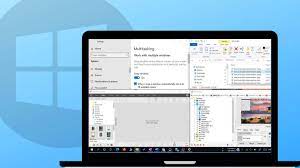Split-screen functionality is a convenient feature on Windows operating systems that allows users to view and work with multiple applications simultaneously, enhancing productivity and multitasking capabilities. Whether you’re comparing documents, monitoring multiple applications, or simply enjoying entertainment while working, knowing how to split the screen on Windows can significantly improve your workflow. In this comprehensive guide, we will explore step-by-step instructions, keyboard shortcuts, and additional tips to help you master the split-screen feature on Windows like a pro.
Table of Contents
Understanding Split-Screen Functionality
What is Split-Screen?
Split-screen, also known as snap assist or multitasking, refers to the ability to display two or more application windows side by side on the screen. This allows users to view and interact with multiple applications simultaneously without having to switch between them constantly.
Benefits of Split-Screen:
- Enhanced Productivity: Split-screen functionality enables users to work on multiple tasks simultaneously, improving efficiency and productivity.
- Better Multitasking: With split-screen, users can easily compare information, copy and paste between applications, and monitor multiple tasks at once.
- Optimal Screen Utilization: Split-screen maximizes screen real estate by utilizing available space more effectively, especially on large monitors or multiple monitor setups.
Methods for Splitting the Screen on Windows
Method 1: Using Snap Assist
Snap Assist is a built-in feature in Windows that automatically arranges open windows when dragging them to the edges of the screen.
- Open Applications: Open the applications you want to display on the screen.
- Drag and Drop: Click and hold the title bar of the first application window, then drag it to the left or right edge of the screen until you see a transparent outline.
- Snap into Place: Release the mouse button, and the window will snap into place, occupying half of the screen.
- Select Second Application: Windows will display thumbnails of other open windows. Click on the thumbnail of the second application you want to display on the remaining space.
Method 2: Keyboard Shortcuts
Windows provides keyboard shortcuts for quickly splitting the screen without using the mouse.
- Windows Key + Left Arrow: Snaps the current window to the left side of the screen.
- Windows Key + Right Arrow: Snaps the current window to the right side of the screen.
- Windows Key + Up Arrow: Maximizes the current window.
- Windows Key + Down Arrow: Restores the current window to its original size or minimizes it if it’s maximized.
Additional Tips for Split-Screen Usage
- Adjust Window Size: Resize application windows by dragging the borders to customize the split-screen layout according to your preference.
- Multi-Monitor Setup: If you have multiple monitors, you can extend the split-screen functionality across multiple displays, allowing for even more multitasking capabilities.
- Use Task View: Task View, accessible by pressing the Windows Key + Tab, provides an overview of all open windows and virtual desktops, making it easier to manage and switch between applications.
- Explore Window Management Tools: Windows 10 offers additional window management features such as virtual desktops, window snapping options, and the ability to create custom layouts using third-party software.
Common Issues and Troubleshooting
- Application Compatibility: Some older or specialized applications may not support split-screen functionality. In such cases, consider updating the application or using alternative methods for multitasking.
- Performance Impact: Running multiple applications simultaneously can consume system resources and impact performance, especially on older or less powerful computers. Monitor system performance and close unnecessary applications to optimize performance.
Mastering the split-screen feature on Windows is a valuable skill that can significantly enhance your productivity and multitasking capabilities. By following the step-by-step instructions, keyboard shortcuts, and additional tips outlined in this guide, you can effortlessly split the screen, work with multiple applications simultaneously, and maximize your efficiency when using Windows. So, whether you’re comparing documents, watching videos, or managing tasks, unleash the power of split-screen and take your Windows experience to the next level!
SF
